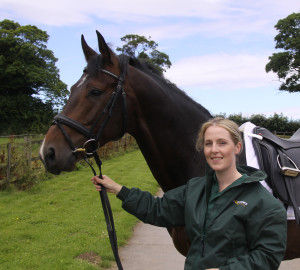Here dressage rider and Equerry-sponsored Georgie Bennett talks us through a few simple flatwork exercises. Georgie explains how to ride half 10 metre circles and turns up the centre line.
Half 10 Metre Circles
By the time you work on 10 metre circles or half circles your horse should be working in a rhythm and balance on 20 metre circles. The movements must be done without resistance or loss of balance or rhythm before the horse is ready to work on a small circle.
The smaller the circle, the greater the demand for the horse to carry himself on his hind legs and engage the hindquarters. For this reason it is always better to work on 10 metre half circles before attempting a full circle.
It is important that the horse does not lose his rhythm, shape or show resistance; better that the circle is a little larger until the horse is physically able to work correctly on a small circle.
This is a good movement to practice to help improve your entry on to the centre line.
10 metre half circles can be performed anywhere in the school, but working from the centre line to the track ensures that the circle is not too big.
However if you work from the boards to the centre line you have the option to then ride straight down the centre line or ride diagonally across back to the boards.
When you have practiced several half circles on their own you can progress to two half circles.
This is best done at ‘E’ or ‘B’ making sure that you do several strides down the centre line over ‘X’, changing the diagonal and balancing the horse before the change of rein.
The aids and the principle of riding the half circle will be exactly the same as for a 20 metre circle. However you will need to be more engaged with this slightly more complex movement.
After completing several of these movements you can than progress to full 10 metre circles.
Turns up the Centre Line
Turns up the centre are not only an integral part of the dressage test but they also play a part in the schooling and warm up of the horse.
Initially the turns on to the centre line can be incorporated with your 10 metre half circles. Make the turn smooth, and look to where you will be going to make sure that you are accurate.
It is important to be exact about the turn so not to over shoot the centre line. The horse must then go absolutely straight up the centre line without wandering.
If the horse is pushed forwards between the rider’s hand and leg, he will be easier to steer and keep straight.
When entering the centre line off the bend, the rider has to execute a half-halt to sit the horse on his hocks prior to the turn and so balance him, and then ride strongly forward with an even contact on reaching the centre line. In doing this, the rider creates enough push from behind to ensure straightness.
This exercise encourages the horse to work more from behind, which is the ultimate aim when schooling.
These turns onto a straight line can also be practiced by turning right or left at ‘E’ or ‘B’. With these turns there is not so much time to ensure that the horse is absolutely straight so the rider must be clear and positive with the aids.
When changing direction by this method, change the flexion at the poll over the centre line and do not allow the horse to swing his shoulders or hindquarters.
When you have practiced this several times you can add halts to your exercise. It is often a good idea not to halt every time you proceed up the centre line as the horse will begin to anticipate the movement.



